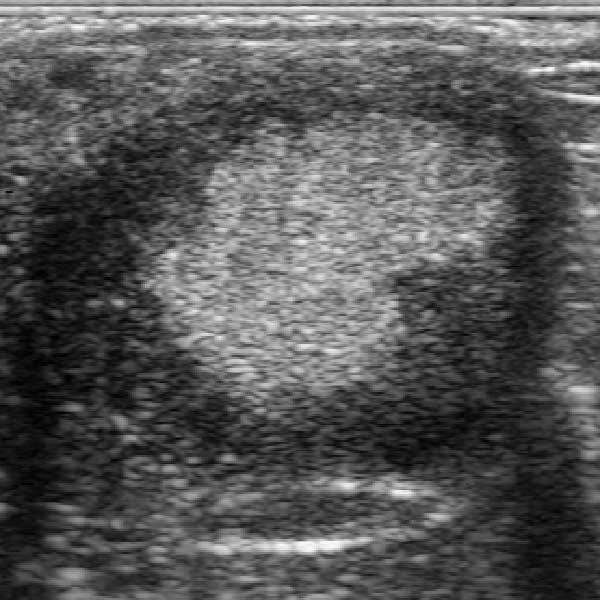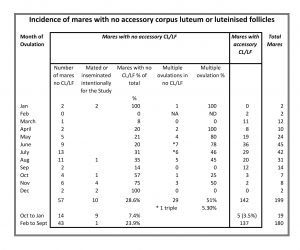Seasonal absence of accessory ovulations in pregnant mares: What is the need for eCG?
By John R Newcombe, Equine Fertility Clinic, Warren House Farm, UK
Introduction
Years before the use of diagnostic ultrasound, WE Allen noticed that secondary luteinised follicles of pregnancy, grew and then regressed in size in 10 day cycles. He suggested this was the result of pituitary FSH secretion rather than the assumption that their development was the direct result of eCG secretion. Most mares are inseminated during the natural breeding season and rarely so late in the season that if not otherwise pregnant, they would then enter a period of winter anoestrus. As a result, little information has been reported on the ovarian activity of such late bred mares. The author had observed that mares conceiving in the autumn did not all subsequently develop any mature follicles, secondary ovulations or luteinised follicles. The pregnancy was maintained by an ultrasonically visible functional corpus luteum. In most cases the CL remained visible and presumably functional for up to 100 days or more, long before which placental progestogen had already taken over the function of pregnancy maintenance. This Clinic’s data base was searched for all pregnancies in which there was no evidence of secondary ovulations nor luteinisation yet remained pregnant until at least 100 days or most likely went to term.
Materials & Methods
The data was additional information recorded in another study on foetal orientation throughout pregnancy. All mares had been examined with ultrasound at least once in the 24 period before ovulation and the number of significant follicles recorded in each ovary. Following ovulation ovaries were examined at least once daily after every ovulation and the number of corpora lutea (CL) recorded. Where this number did not match the number of follicles which had apparently ovulated, repeated further examinations were made to clarify any discrepancy. Pregnancy diagnoses were then made routinely at Days 12-15 after ovulation, again at about 21 days and again at around 30 and 40 days. At each examination, a detailed inspection of the ovaries for functional CL was made and recorded. On a few occasions, a second or third CL was either not seen or had not been recorded. The ‘missing’ CL was subsequently ‘re-discovered’ at a later examination
However, conversely sometimes an ‘extra’ CL was seen , not corresponding to the number seen post-ovulation. At 21 days the new CL was obvious from its appearance, to be a late dioestrus ovulation from a follicle often identified at the 12-15 day examination. The new CL and the CL verum were then seen and recorded at all subsequent examinations. At 35-45 days one or more large follicles were commonly found some of which were seen to ovulate, mostly at about 38-45 days. By 50 days the ovaries could then contain up as many as 5 CLs, e.g. one or two CL vera, one dioestrus and one or two secondary CLs from 40+ day ovulations. In contrast the pregnancy may still be supported by a single CL verum. From 65 days onwards, due to circulating equine Chorionic Gonadotrophin, new follicles began to develop and to subsequently luteinise and were recognised as luteinised unruptured follicles (LUF). As they mature, LF become increasingly similar to normal mature CL. Repeated examinations at this time recognised the appearance of any new CL or LUF in addition to the CL verum and any CL from earlier dioestrus ovulations. In this study from recording the number of luteal structures (LS) in each ovary, it was possible to correlate this with any earlier data from the same mare.
Although early dioestrous ovulations were in minority, many mares ovulated at around 38-45 days. However there were instances of mares in which there were no dioestrous ovulation (no extras CL), no accessory CL from 40 day ovulations and no subsequent luteinised follicles. It was apparent that in these cases, no ovulatory size follicle and often not even relatively small follicles were recorded. The ovaries had ceased to develop new follicles so that it was not possible for any ovulation or luteinisation. Yet the pregnancies continued to develop normally, maintained in some cases by a single corpus luteum verum. Although blood samples were not taken, since few of these pregnancies failed, it is reasonable to assume that endometrial cups developed and eCG was secreted.
Observations of foetal orientation were made irregularly throughout the breeding season and winter. Thus data was available from most of the year. It became obvious that although some mares which conceived during the normal breeding season failed to develop luteal structures, the majority of such instances was in mares which became pregnant late in the season or during autumn and winter.
Over 700 observations of pregnant mare ovaries were made between Day 29 to Day 350. All mares had been observed as previously described and the number of CL up to Day 29 or later authenticated. In total 199 pregnancies were followed in which suitable data had been recorded.
Results
57 pregnancies were followed in 34 ‘in house’ mares over 145 observations (2.5 obsv/preg) in which no ovulation nor luteinisation was observed. On 4 (2.9%) occasions, one CL was not found and not re-discovered. This occurred between 33 and 51 days, 42 and 119 days, 53 and 81 days and 69 and 141 days. All CL had disappeared in two mares by 108 and 141days.
In 9 mares other than the 34, both primary and secondary luteinisation CL were detected as late as 134 days (1 new), 142 days (2 new of 3), 142 days (2 of 5), 142 days (1,) 146 days (1 of 2), 147 days (1 of2) and 149 days (1). After 120 days and up to 150 days, in only 25 of the 102 observations (25%) were CLs observed, although at 67 observations there was no data recorded. Ovaries were observed with no visible CLs at 161, 163, 165, 171, 183, and 185 days. In two mares given PGF2a with visible CL at 107 and 122 days, no CL was seen one week later.
Seasonal effect
The percentage of pregnancies with no CL other than the CL verum which conceived in each month was Jan 100% (2). Feb 0% (2) March 9% (12) April 20% (10) May 26% (24), June 20% (45), July 31% (42), August 35% (31), Sept 14% (14), Oct 57% (7), Nov 75% (8) Dec 100% (2). The 14 mares with no LS , which conceived between October and January, accounted for 74% of the total compared with 24% (n=180) which conceived between February and September. Any mare which had ovulated between October and January, at 30 days of pregnancy would have been examined between November and February, at 60 days between December and March or at 91 days between January and April. Other observations from this Clinic have found that maiden and barren anoestrous mares, wintered outside under the same ambient conditions, had the same mean first ovulation date of April 23 (+/- 1 days) over 10 years (Unpublished). While some of these mares had entered a period of seasonal anoestrus in October and November, the majority had the last ovulations in December. This combined with the data on first ovulation dates, indicates that under ambient conditions at this Clinic, apart from a few mares which continued to cycle throughout the winter, the vast majority were anoestrus between December and most of April. These months correlate with the same period when 74% of those mares which conceived between October and January would have been pregnant between 30 and 90 days.
Multiple ovulation effect
The overall MO rate in mares without secondary luteal structures was 51% much higher than has been previously reported at this Clinic or in other studies including 3 (5.3%) triple ovulations. The peak incidence (of 60%) was from April to August as has been previously reported, but much higher than previously reported.
Discussion
This study is based on retrospective data recorded from the observations of a single practitioner over many years. Evidence that mares retained the pregnancy with only the corpus luteum verum without any secondary ovulations or luteinisation was based solely on those observations. Whilst the number of follicles which ovulated at and just after oestrus was verified by the number of CLs observed at several post-ovulation observations, the possibility of an unobserved ovulation at a later date, and especially from the less frequent observations made after 50 days, could not be ruled out. However the instances where one CL had disappeared only to be observed again later were few and the instances where the missing CL was not rediscovered only 2.9%. Similarly, where there appeared to be an ‘extra’ CL from an unobserved ovulation were very few provided that the original number were found at a later observation. Where the ‘extra’ CL continued to be found, then the pregnancy was discounted from the nil group. Therefore the author believes the data to have a high degree of accuracy.
The study suggests that the CL verum visibly persists in the ovaries of pregnant mares long after placental P4 is sufficient to take over that role and much longer than has been previously reported. The CL verum and any other CL/LF were progressively absent from about 100 days. The last positive observation was at 167 days. However its visible presence as in this study, is not proof that any luteal structure is still secreting P4. The rapid disappearance of a visible CL, soon after PGF2a was given at 107 and 122 days does suggest functionality up to that time.
The study confirms previous reports that dioestrus and early pregnancy ovulations occur sporadically. That ovulations at and around 6 weeks are common and that most, but not all mares, have secondary ovulations and luteinised follicles from 50-60 days onwards. However while pregnancy without any secondary luteal structure may have been reported before, the high incidence has not. It is notable that while the incidence has a significant seasonal distribution, there is still a 20% to 35% incidence in the summer months when the incidence of multiple ovulation is highest. The high (winter) seasonal incidence can be explained by low pituitary FSH secretion causing an absence of suitably mature follicles to either ovulate or luteinise. It is suggested the correlation between multiple ovulation summer, if not coincidental, could be that the high P4 resulting from the double ovulation has some negative feedback on follicle growth or maturation.
Conclusion
In this study 74% of 19 mares which did not have any secondary ovulations or luteinisations conceived between October and January. The pregnancies relied upon the continued secretion of progesterone from the primary corpus luteum (verum) until at least placental progestogens were sufficient. Since FSH secretion in seasonally anoestrous mares may be insufficient to induced the development of mature follicles, it is concluded that the same applies to pregnant mares at the same time of year where the absence of sufficiently mature follicles meant that no secondary ovulations or luteinisations were possible.
Question
What therefore is the role of eCG if not needed to induce new luteal structure to provided luteal support of the pregnancy?
© 2023 Professor John Newcombe, BVetMed, MRCVS




